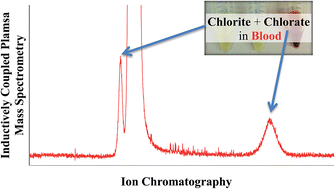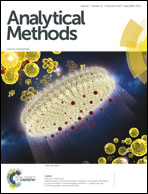Chlorine speciation analysis in blood by ion chromatography-inductively coupled plasma mass spectrometry
Abstract
At present, chlorate salts are discussed as potential in vivo disinfectants in food animals. However, the ongoing metabolism studies rely on robust and sensitive methods. Therefore, a method for the determination of chlorine species in blood was developed. After their ion chromatographic separation, chlorate and chlorite were detected by single-quadrupole inductively coupled plasma mass spectrometry (IC-ICPMS). The suitability of the method was evaluated with spiking experiments. Estimated detection limits of ∼0.1 mg Cl L−1 for chlorite and ∼0.2 mg Cl L−1 for chlorate in measurement solutions (injection volume 20 μL) and ∼0.5 mg Cl L−1 for chlorite and ∼1.0 mg Cl L−1 for chlorate in blood were obtained. In order to overcome the interfering 18O16O1H+ and 36Ar1H+ ions, IC was also coupled to a triple-quadruple ICPMS (ICPQQQMS) operating in MS/MS mode with hydrogen as reaction gas. However, the signal-to-background ratios and, hence, the detection limits could not be improved due to a constant chlorine background. However, with appropriate sample preparation, the method is suitable for the determination of anionic chlorine compounds in blood.


 Please wait while we load your content...
Please wait while we load your content...